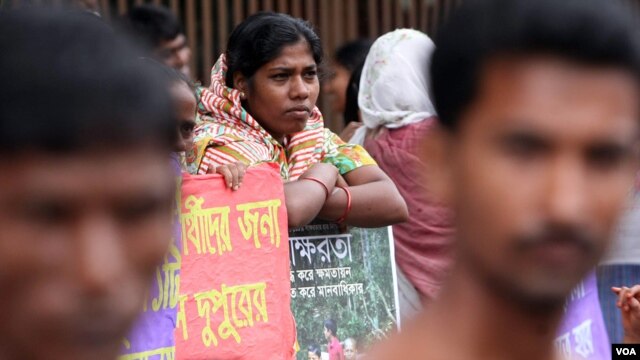
File - Bangladeshis participate in a rally marking International Literacy Day, in Dhaka, Bangladesh.
DHAKA, BANGLADESH—
Bangladesh has the world’s fourth-highest rate of child marriage, despite big gains in health and education for girls and women. Yet its government wants to allow girls to marry at age 16.
A government proposal to lower the age of marriage for women from 18 to 16 would be a “terrible” setback for Bangladesh, which has made notable progress on health and education, said Human Rights Watch.
The legal age of marriage will remain at age 18 for girls, but under a proposed new clause, marriage will be legal at age 16 under special circumstances, such as parental or judicial consent or unplanned pregnancy.
Plan International Bangladesh, the child protection non-profit, said, “Essentially, the new clause will allow the continuation of child marriage and prove perilous for young people in Bangladesh.”
Disbelief over proposal
Human rights activists and other advocates are baffled by the proposal, which came in spite of Prime Minister Sheikh Hasina’s pledge in July 2014 at the Girl Summit in London to combat child marriage in Bangladesh. The proposal also seeks to lower the age of marriage of men from 21 to 18.
Heather Barr, a senior researcher at Human Rights Watch, said, “It’s really shocking that Bangladesh would be looking backwards and away from international standards and international law. This law would have direct and real harmful effects on girls … It will send message to parents of girls of all ages that child marriage is alright.”
Human Rights Watch this week published a report that condemned what it calls Bangladesh’s “epidemic” of child marriage.
UNICEF reports that 29 percent of girls in Bangladesh married before age 15. The south Asian country has the fourth-highest rate in the world of child marriage before age 18 - behind Niger, the Central African Republic, and Chad.
In Bangladesh, 64 percent of women married before the age of 18, according to a survey from Plan International.
Barr of Human Rights Watch said the government’s proposal harms more than just Bangladesh’s image.
“It has the potential to over time undermine Bangladesh’s progress on important development indicators like literacy, maternal mortality and infant mortality,” she said.
Devastating impact
Early marriage is linked to maternal deaths and low education when girls drop out of school. Girls between the ages of 10 to 14 years old are five times more likely to die during childbirth than mothers aged 20-24, according to medical researchers.
Girls between 15 years old and 19 years old still are twice as likely to die during delivery than women aged 20-24. And girls married before age 15 are more likely to be abused by spouses than women married after 25.
Human Rights Watch interviewed dozens of married girls across the country, some as young as 10. Families were largely driven to marry off daughters because of desperate poverty, as well as natural disasters, lack of access to education, social pressure, harassment, and dowry.
“We were very poor – sometimes we would eat every two or three days,” said Lucky C, a girl married at 15, who was quoted in the report. “Even though they [my parents] really wanted all three of their daughters to study, it wasn’t possible, so they got me married.”
The report listed more than 70 policy recommendations to combat early marriage. Barr emphasized that local government officials must not take bribes to permit early marriage or to fake birth certificates.
The high rate of child marriage is paradoxical for Bangladesh, which is known for substantial progress in development. Maternal mortality declined by 40 percent between 2001 and 2010.
Bangladesh also enrolls as many girls as boys in primary and secondary school, according to the United Nations. Overall, Bangladesh reduced poverty from 56 percent in 1991-1992 to 31 percent by 2010.
Cascading fallout
However, a paper published this year in the journal Asian Population Studies found that in a sample of 1,766 women in an area called Matlab in south-central Bangladesh, 56 percent underreported their age by about two years.
The study was conducted by researchers at icddr,b, the renowned public health institution in Dhaka. Matlab is icddr,b’s rural field site, which has been collecting demographic and health data from residents since 1966.
Among a group of married women aged 20 to 24, the reported average age of marriage was 16.8 years, according to the study. However a cross-check with their actual dates of birth recorded in icddr,b’s database showed the actual average age at marriage was 18.6 years.
The paper said dowry was the most likely reason for misreporting age since the families of older women typically have to pay larger dowries.
Yet Dr. Peter Kim Streatfield, lead author of the paper and emeritus scientist at icddr,b, said early marriage and security against poverty remain major problems.
“It doesn’t change the fact that large numbers of women are still marrying too young. One of the reasons is the declining security situation for young women," said Streatfield. "Government would be better off ensuring security for young women and trying to encourage them to stay in school as long as possible rather than just changing a number.”
Early marriage continues to be an ingrained problem in Bangladesh that must be tackled. |
|
